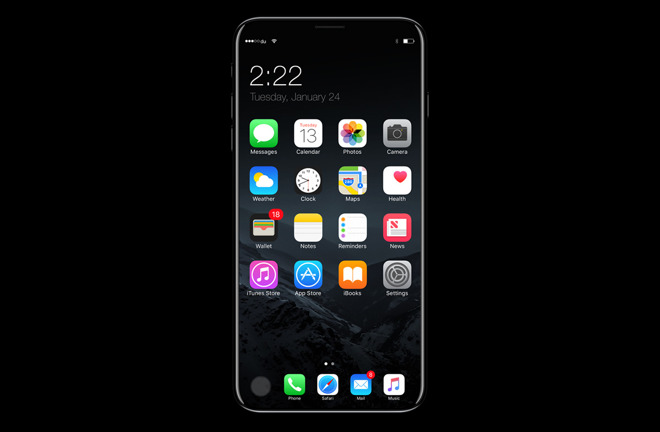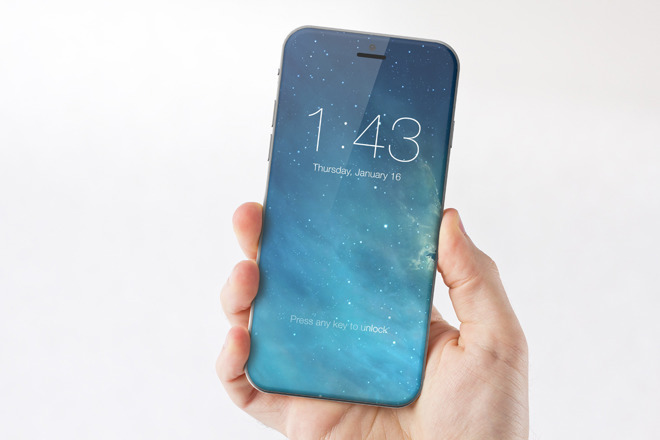All of Apple's 2017 iPhones will include fast charging via Lightning port, not USB-C
While the underlying technology behind the charging may change, the Lightning port will remain on all of Apple's three new iPhones coming later this year -- including the flagship "iPhone 8" -- according to analyst Ming-Chi Kuo of KGI Securities.
Apple is expected to utilize "Type-C Power Delivery" technology in this year's iPhones, Ming-Chi Kuo said in a research note on Thursday, a copy of which was obtained by AppleInsider. The note specifically refutes a questionable claim made earlier this week by The Wall Street Journal, which suggested Apple could ditch the Lightning port with this year's "iPhone 8," instead switching to the same USB-C port found on the company's latest MacBooks.
That rumor was unlikely for a number of reasons, including a lack of clear advantages in changing the connector type. But one key advantage instead lies in the underlying technology, which can be integrated into Apple's own proprietary Lightning port.
Kuo noted that safety and stable data transmission during a fast charge are crucial elements for Apple to nail in the switch. He believes the company will adopt power management from Texas Instruments and power delivery chips from Cypress.
In addition, the high-end "iPhone 8" may boast even faster charging thanks to a 2-cell L-shaped battery pack design. Still, "Type-C Power Delivery" is expected on all three handsets this year.
Kuo noted that one potential advantage for switching to USB-C would be faster transfer of high-definition videos. However, he said that high-speed data transmission is a "niche application" for the iPhone, which is why Apple will stick with the Lightning port.
The Lightning port is slightly thinner than USB-C. It also allows Apple to collect royalties on its Made for iPhone program, which licenses use of the Lightning port.
As AppleInsider noted earlier this week, Apple has doubled down on Lightning accessories in the last few years, making abandonment of the port on its flagship device extremely unlikely. Use of the proprietary connector has expanded from "iDevices" to accessories, including the Apple Pencil, Apple TV Siri Remote, AirPods, and BeatsX headphones, among others.
Instead, it's more likely that Apple might switch to a USB-C connector on the opposite end of the Lightning cable that ships in the box. That would allow users to plug their "iPhone 8" into one of the company's new MacBook Pros, or the 12-inch MacBook.
Beyond fast charging via Lightning, Apple is also expected to introduce contact-based wireless charging for all three iPhone models this year, including the "iPhone 7s" and "iPhone 7s Plus." The addition would allow users to juice their device by simply placing it on a compatible charging pad.

'iPhone 8' concept image by Moe Slah.
The flagship "iPhone 8" is expected to stand out in a number of ways, including its price tag, rumored to start above $1,000. The handset is said to feature an all-new, all-glass exterior with a curved OLED display that will embed components like Touch ID, the earpiece and the FaceTime camera into or beneath the screen.
The forward-facing camera is also expected to see a major overhaul with "revolutionary" 3D facial recognition technology, allowing for a new secure biometric login method. The device is also expected to ditch the physical home button that has been found on every iPhone to date, replacing it with a display function area below the OLED panel, dedicated to system functions with virtual buttons.
The "iPhone 8," "7s," and "7s Plus" are all expected to debut in Apple's usual September timeframe. The "iPhone 7s" series is believed to feature largely the same design and form factor as the current iPhone 7 lineup, allowing the premium "iPhone 8" design to stand out.
Apple is expected to utilize "Type-C Power Delivery" technology in this year's iPhones, Ming-Chi Kuo said in a research note on Thursday, a copy of which was obtained by AppleInsider. The note specifically refutes a questionable claim made earlier this week by The Wall Street Journal, which suggested Apple could ditch the Lightning port with this year's "iPhone 8," instead switching to the same USB-C port found on the company's latest MacBooks.
That rumor was unlikely for a number of reasons, including a lack of clear advantages in changing the connector type. But one key advantage instead lies in the underlying technology, which can be integrated into Apple's own proprietary Lightning port.
Kuo noted that safety and stable data transmission during a fast charge are crucial elements for Apple to nail in the switch. He believes the company will adopt power management from Texas Instruments and power delivery chips from Cypress.
In addition, the high-end "iPhone 8" may boast even faster charging thanks to a 2-cell L-shaped battery pack design. Still, "Type-C Power Delivery" is expected on all three handsets this year.
Kuo noted that one potential advantage for switching to USB-C would be faster transfer of high-definition videos. However, he said that high-speed data transmission is a "niche application" for the iPhone, which is why Apple will stick with the Lightning port.
The Lightning port is slightly thinner than USB-C. It also allows Apple to collect royalties on its Made for iPhone program, which licenses use of the Lightning port.
As AppleInsider noted earlier this week, Apple has doubled down on Lightning accessories in the last few years, making abandonment of the port on its flagship device extremely unlikely. Use of the proprietary connector has expanded from "iDevices" to accessories, including the Apple Pencil, Apple TV Siri Remote, AirPods, and BeatsX headphones, among others.
Instead, it's more likely that Apple might switch to a USB-C connector on the opposite end of the Lightning cable that ships in the box. That would allow users to plug their "iPhone 8" into one of the company's new MacBook Pros, or the 12-inch MacBook.
Beyond fast charging via Lightning, Apple is also expected to introduce contact-based wireless charging for all three iPhone models this year, including the "iPhone 7s" and "iPhone 7s Plus." The addition would allow users to juice their device by simply placing it on a compatible charging pad.

'iPhone 8' concept image by Moe Slah.
The flagship "iPhone 8" is expected to stand out in a number of ways, including its price tag, rumored to start above $1,000. The handset is said to feature an all-new, all-glass exterior with a curved OLED display that will embed components like Touch ID, the earpiece and the FaceTime camera into or beneath the screen.
The forward-facing camera is also expected to see a major overhaul with "revolutionary" 3D facial recognition technology, allowing for a new secure biometric login method. The device is also expected to ditch the physical home button that has been found on every iPhone to date, replacing it with a display function area below the OLED panel, dedicated to system functions with virtual buttons.
The "iPhone 8," "7s," and "7s Plus" are all expected to debut in Apple's usual September timeframe. The "iPhone 7s" series is believed to feature largely the same design and form factor as the current iPhone 7 lineup, allowing the premium "iPhone 8" design to stand out.


Comments
The transfer speed isn't much of an issue since most users don't plug in their iPhone to transfer data.
The next port change for the iPhone will be no port at all.
I agree that the next, or at least the best, port will be no port. For access when wireless charging and connectivity fails or for higher speed connectivity all phones should include the 'smart connectors', of course.
That would be a seriously respectable transition strategy.
I use Apple chargers and cables or Made for iPhone chargers and cables, because they are superior in quality to cheap ones. There's no good reason to use the knockoffs --> see various stories involving iPhones, etc., being destroyed because of using cheap, crappy cables / chargers.
Unfortunately, this mean we pay more for Apple products for an en expectations of legal fees, more intense testing, and paying for better components, but the latter two I'm happy to pay for, assuming it's not done to excess so that the net gain is, say, less than 0.00001% while being an increase in component testing by, say, 100 fold.
If you're suggesting that the physical port interface could be made to work as both a USB-C and Lightning port interface, I don't think that's possible, nor do I see a benefit from Apple's PoV even if it was possible without any connectivity issues.
Also, MFI cables don't invalidate any warranties.
Umm that's not true... Apple recommends using any accessories certified through their MFi program, they do not specifically recommend, "Apple only". And yes the profit margin is huge on Apple's accessories, but as the other poster said, it's still a tiny drop in the bucket of overall sales.
Apple charges more for two reasons...
1. They pretty much use the highest quality components.
2. Leaving space at a lower price tier allows 3rd parties to come in and offer an alternative - this is how you build viable markets around your products.
Apple could almost certainly offer anything and everything any 3rd party vendor could, but they choose not to. Instead they offer a platform by which others can build on top of. This is how you create, build and maintain a thriving ecosystem. Offering it all yourself, leaves little room for others to invest in your platform/ecosystem. This is why, even though there are 4-5 times more Android devices in the world, the iOS ecosystem is by far much, much larger and desirable.